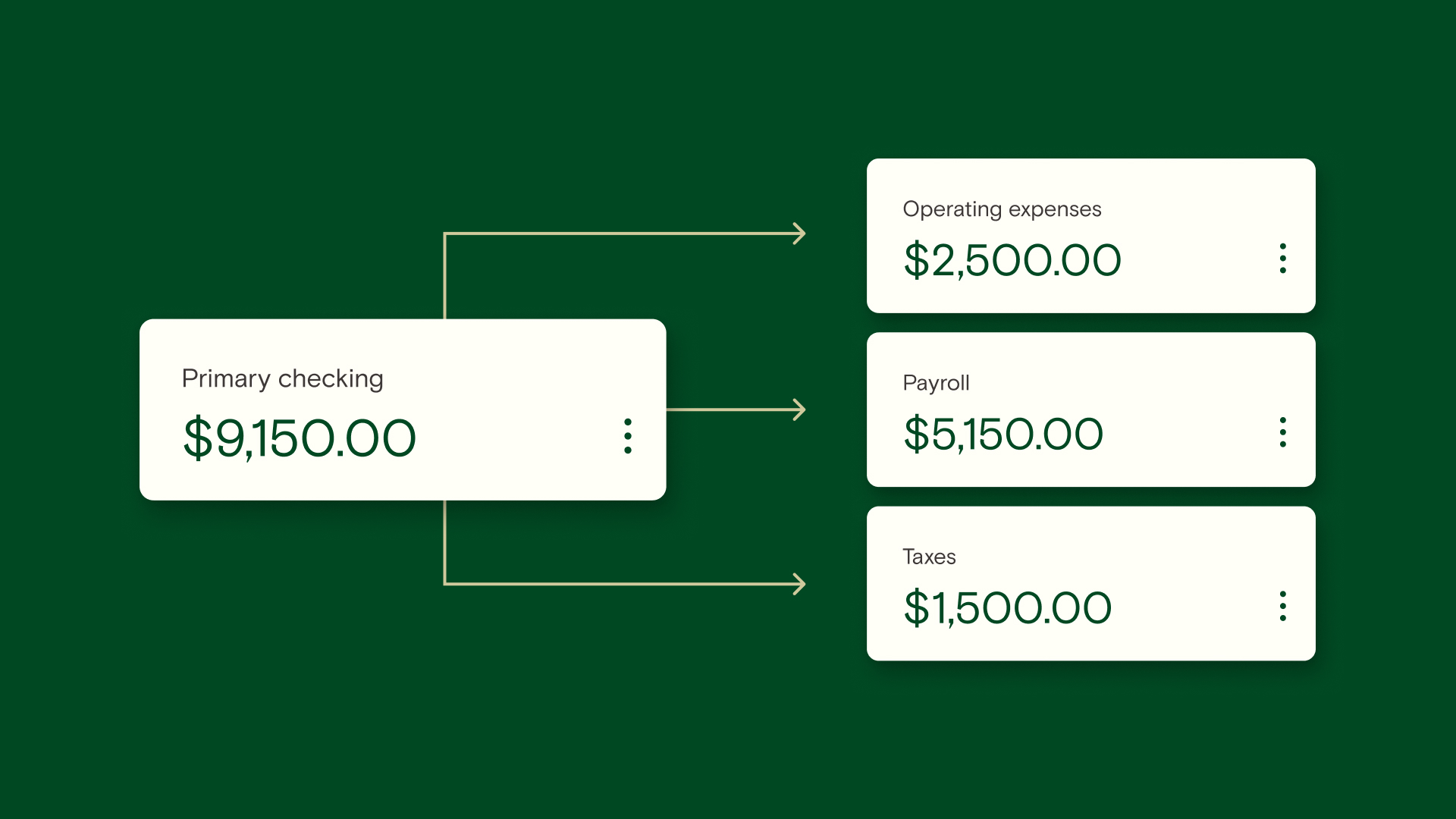Multiple accounts, on the other hand, can give you a clear picture of your income, expenses, and savings. 💸 But exactly how many business checking accounts should you have?
The right answer will depend on your unique business needs. Generally, however, the more checking accounts you have, the clearer your cash flow will become. Multiple bank accounts can also help you stay on budget and meet your business financial goals faster.
Let's explore.
How many business checking accounts should I have?
As a small business owner, separating your business and personal finances is always a good idea. Opening at least one business checking account will protect your personal assets, simplify bookkeeping, and make filing your taxes a lot easier.
💡If you’re still using your personal account for business income and expenses, check out these 7 reasons to separate business vs. personal bank accounts.
While having one business checking account is okay, opening multiple accounts is even better. So, exactly how many checking accounts a business should have? Let’s break it down.
Great: Two business checking accounts 👍
At a minimum, business owners should consider having at least two accounts: one for income (to receive money) and one for expenses (to pay bills). This basic structure allows you to clearly distinguish what's coming in from what's going out, giving you a bird’s eye view of cash flow.
Better: Four business checking accounts 🌟
To get further visibility into cash flow, you could open four separate business checking accounts: income, expenses, taxes, and payroll (for paying employees or yourself). Each month, revenue would be deposited into the income account and then transferred to your other three accounts.
This type of budgeting with multiple bank accounts can take the stress out of your business finances. At a glance, you’ll know if you have enough money to cover your most important expenses each month—no mental math required.
Best: 5 Profit First checking accounts 🏆
The Profit First method of cash management involves intentionally dividing revenue across different bank accounts, including a profit account. Developed by entrepreneur Mike Michalowicz, Profit First calls for 5 main business checking accounts:
Income
Profit
Taxes
Owner’s Pay
Operating Expenses
To implement Profit First, all revenue is deposited into the income account. Then, you transfer a percentage of income to your profit account first, even if it’s as small as 1% (we all start somewhere!). After setting aside profit, you can then transfer different percentages of the remaining income to taxes, owner’s pay, and operating expenses.
This method has been proven to help business owners make profit a habit. Instead of allowing expenses to outgrow or keep pace with revenue, Profit First helps small business owners become immediately and permanently profitable.
5 reasons to have multiple checking accounts
Opening multiple bank accounts can sound like a lot of work—so is it worth it? Absolutely. While it might sound counterintuitive, having more than one checking account can actually speed up cash flow management.
Is it easy to open more than one bank account for business?
And though most financial institutions make it hard to switch your payments and transactions to multiple checking accounts, Relay (that’s us! 👋) makes it fast and convenient. Our new in-app switching checklist can help you get started with multiple checking accounts in minutes instead of months.
💡 Learn more about Relay’s online business banking and money management platform.
Still wondering if you should have more than one checking account? Here are 5 reasons to open multiple checking accounts for your business:
💸 Get crystal clear on cash flow: By separating your funds into different accounts, you can quickly understand your business's financial health—no spreadsheets required.
💰 Simplify money management: Multiple checking accounts can give your day-to-day budget structure and speed up cash flow management.
💳 Stay on top of spending: Setting up individual checking accounts for different expenses takes the guesswork out of spending. At a glance, you’ll know if you’re sticking to the budget — or veering off.
🔐 Added security: Having multiple bank accounts limits the impact if one is compromised. Even if one account takes a hit, you’ll still be able to pay your bills and maintain business operations.
🗂 Streamlined bookkeeping: Say goodbye to disorganized business transactions — with multiple bank accounts, you and your bookkeeper will know exactly where each dollar is going.
Ultimately, multiple checking accounts can help you grow your business by giving you a clear picture of how you earn, spend, and save.
Choosing the right bank for multiple business checking accounts
Before opening multiple checking accounts, it’s important to compare traditional vs. digital banks. Digital banking platforms typically offer lower account fees and more flexibility. By contrast, traditional banks often have inconvenient requirements that can make it tough to open more than one checking account.
So what’s the best business banking option for multiple accounts? Let’s take a closer look.
🏦 Traditional banks
If you already have a business checking account with a traditional bank, you might consider opening additional accounts there. However, outdated infrastructure and complex processes might make it time-consuming and difficult to open more than one checking account.
Traditional banks create various challenges for small business owners seeking to open multiple checking accounts, including:
Multiple in-person branch visits 😬
Tedious paperwork 📑
Long waiting periods for account approval ⏰
Steep account fees 💵
Minimum deposit to open a new account 💰
Minimum balance requirements 😕
Limited or nonexistent financial management tools 🙅
💻 Digital banking platforms
Online banking platforms like Relay offer a secure, convenient, and user-friendly alternative for small business owners who want to open and manage multiple checking accounts. By using more modern processes and technology, digital banks are able to streamline the account opening process and eliminate the need for in-person visits and tedious paperwork.
Many online banking platforms are designed specifically to meet the needs of business owners, offering perks like:
Low or no-fee business checking accounts 🙌
No minimum balance or deposit requirements 💸
Ability to open multiple accounts completely online 💻
Money management features like accounts payable automation 🛠
Integrations with accounting software and financial tools 📊
Virtual debit cards and team spending controls 💳
Advanced security features and fraud detection 🔐
Across the board, online banking platforms are the most convenient and cost-effective option for small business owners to open multiple accounts.
Ready to open multiple business checking accounts?
Choosing a business bank account can be tricky. Even if you already have an account, your bank might not be the best choice for opening multiple accounts.
Relay gives small business owners the ability to open 20 free business checking accounts — with no monthly fees, overdraft fees, or minimum balance requirements. 🙌💸 Relay is FDIC insured through Thread Bank. Relay offers 50 virtual or physical debit cards, free ACH payments, percentage-based auto-transfer rules, and more.
With Relay, you can spend, save and plan more efficiently and get unparalleled clarity into operating expenses, cash flow, and accounts payable. If you’re looking for a new business checking account, make the switch to Relay today.
FAQs about opening multiple business checking accounts
Want to dive deeper? Check out these answers to the most common questions about setting up multiple business bank accounts. 💭
What are sub-accounts vs. multiple checking accounts?
Sub-accounts are virtual subdivisions within a single main account, allowing users to allocate funds for specific purposes. Sub-accounts lack the same level of separation and protection as individual checking accounts, which are standalone accounts with distinct legal and financial identities.
How many bank accounts does the average business have?
The number varies depending on the size and complexity of the business. A small business may have two to three accounts, while a larger or more complex business may have more.
Should I have multiple business savings accounts?
Saving as a business is important. You might want separate accounts for various purposes, such as an emergency fund for unexpected expenses and a high-yield savings account for long-term savings goals. With Relay’s business savings account, you can earn 1-3% APY on every spare dollar.**
Should I use multiple business credit cards?
Utilizing different business credit cards can help you organize expenses and earn rewards tailored to specific spending categories. However, having multiple credit cards can cause you to pay interest on business spending. It may also be difficult to get true cash flow visibility across different credit cards, vs. seeing all your outflows and inflows reflected in your business checking accounts.






